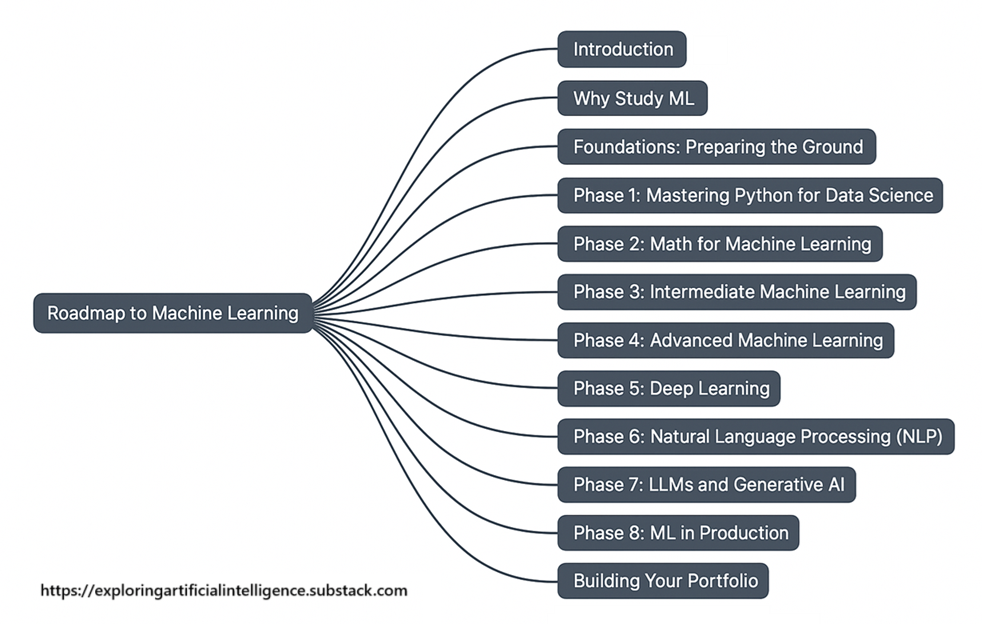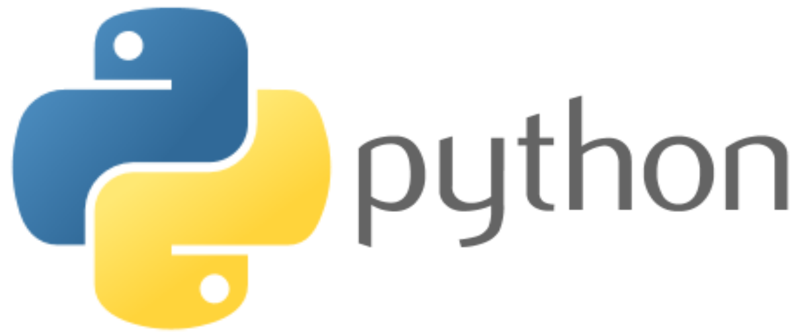The Best Path to Mastering Artificial Intelligence – A Complete Guide (Part 1)
An accessible, practical, and powerful roadmap for anyone looking to enter — and master - the world of Artificial Intelligence.
Artificial Intelligence (AI) is redefining the world. It's in the apps we use, in medical diagnostics, in industry, in the code we write. And those who master this technology are one step ahead.
But… where to start (or catch up) with so much information?
With so many new terms like LLMs, SLMs, Generative AI, MLOps, diffusion models, etc., it really is hard to keep up.
This post presents the first part of a complete and up-to-date roadmap, from basic foundations to the most advanced technologies, including links to courses, videos, and free materials that will help you at every stage of the journey.
Whether you’re a student, a professional looking to change careers, or simply someone curious about the subject, this guide is designed to offer a clear and structured path.
Let’s go!!
Why Study AI and Machine Learning?
Before diving into the roadmap itself, it’s worth understanding why studying AI and Machine Learning (ML) is so relevant today.
The job market in AI is booming, with companies investing heavily in this area and creating opportunities in various sectors like healthcare, finance, retail, education, entertainment, and many more.
Professional profiles in the field are diverse: data scientists, machine learning engineers, NLP (Natural Language Processing) specialists, AI researchers, MLOps engineers, among others. Each of these paths offers unique challenges and rewards, allowing you to find a trajectory aligned with your interests and skills.
Beyond professional opportunities, AI is redefining how we interact with technology and solve complex problems. It allows us to automate repetitive tasks, make data-driven decisions, personalize experiences, and even create art, music, and text with the help of generative models.
With the emergence of LLMs (Large Language Models) and Generative AI, we are witnessing a new revolution within the AI revolution. These technologies are democratizing access to AI and opening up possibilities that once seemed like science fiction. It’s a great time to enter this field!
Foundations: Preparing the Ground
Before starting your journey in AI and ML, it’s important to ensure you have a solid foundation. Don’t worry if you don’t have a background in computer science or advanced math - many successful professionals in the field came from completely different areas.
To begin, you’ll need:
Basic programming knowledge: You don’t need to be an experienced developer, but understanding fundamental programming concepts like variables, loops, conditionals, and functions is important.
Basic math: Knowledge of algebra, basic statistics, and logic will be useful. Don’t be intimidated by terms like “calculus” or “linear algebra” — we’ll approach these topics gradually.
Curiosity and persistence: Perhaps the most important requirements! The learning journey in AI has its ups and downs, and the ability to persist through challenges will make all the difference.
Remember: you don’t need to fully master these fundamentals before starting — you can improve them along the way.
Phase 1: Mastering Python for Data Science
Python has become the standard language for AI and ML due to its simplicity, readability, and vast ecosystem of specialized libraries. In this first phase, you will become familiar with Python and the main tools for data manipulation and analysis.
Basic Python
If you’re completely new to Python, start with introductory courses that cover basic syntax and fundamental concepts of the language. Some suggestions to get started:
Python Course by Dave Gray: A well-explained YouTube video course with clear language.
Interactive Python Course from futurecoder.io: A free and interactive platform to learn Python from scratch.
Dedicate a few weeks to these resources, practicing regularly with small exercises and projects. Don’t worry about memorizing everything — the important thing is to understand the concepts and know where to find information when needed.
Libraries for Data Science
Once you have a basic understanding of Python, it’s time to explore the essential libraries for data science:
NumPy: Fundamental for numerical computing in Python, NumPy provides support for multidimensional arrays and high-performance mathematical functions.
Data Manipulation with NumPy – Official beginner’s guide.
Pandas: Essential for manipulation and analysis of structured data, Pandas allows you to import, clean, transform, and analyze data efficiently.
Kaggle’s Pandas Course – Excellent introduction with practical exercises.
Data manipulation on mlcourse.ai – Complete material on data manipulation.
Matplotlib and Seaborn: Data visualization libraries that allow you to create informative and attractive charts.
Data visualization on mlcourse.ai – Introduction to data visualization.
Matplotlib Gallery – Visual examples with code.
Seaborn Gallery – Examples of statistical visualizations.
Practice using these libraries by analyzing real datasets. Kaggle offers thousands of free datasets on various topics, from sports to public health!
Initial Practical Project
To consolidate your learning in this phase, try to create a simple exploratory data analysis project. For example:
Analysis of COVID-19 data
Exploration of movie or music datasets
Analysis of climate data from your region.
Share your project on GitHub and ask the community for feedback. This will be the first item in your data science portfolio! 😊
Phase 2: Math for Machine Learning
Many AI beginners fear the math involved, but with the right approaches, these concepts can be learned in an intuitive and visual way. In this phase, we’ll focus on the essential mathematical foundations for ML.
Linear Algebra
Linear algebra is fundamental to understanding how ML algorithms work "under the hood." Fortunately, there are excellent resources that make this learning more accessible:
Linear Algebra Tutorial with Python – Practical implementation with Python to consolidate learning.
We’ll focus on understanding concepts like vectors, matrices, linear transformations, eigenvectors, and eigenvalues. Don’t worry about mastering everything — the important thing is to grasp the intuitions and applications.
Statistics and Probability
Statistics and probability form the “backbone” of machine learning. These concepts help you understand how models learn from data and make predictions:
Crash Course in Statistics – A quick introduction to statistical concepts.
Focus on concepts like probability distributions, hypothesis testing, confidence intervals, and correlation. These fundamentals will be important when we start evaluating ML models.
Practical Application
To make math learning more concrete, try implementing some concepts in Python:
Create visualizations of linear transformations
Analyze statistical distributions in real datasets
Remember: the goal is not to become a mathematician, but to develop enough intuition to understand how ML algorithms work.
Phase 3: Machine Learning Fundamentals
Now that you have a solid foundation in programming and math, it’s time to dive into the fundamental concepts of machine learning. This phase will introduce the main types of algorithms and how to apply them to real-world problems.
Check out: Top 8 Machine Learning Algorithms: Everything You Need to Know
Basic Concepts and Terminology
Before diving into specific algorithms, it’s important to understand the foundational concepts that permeate the entire ML field:
Machine Learning Course by Andrew Ng (Coursera) – A great introduction to ML.
Google’s Machine Learning Crash Course – A free, practical-focused course from Google.
Familiarize yourself with terms like features, labels, training, validation, testing, overfitting, underfitting, bias-variance tradeoff, among others.
Supervised Learning
Supervised learning is a type of machine learning where the model learns from labeled data — that is, examples with known answers — to predict or classify new information. Some examples:
Regression
Regression algorithms predict continuous values, such as prices, temperatures, or ages:
Linear Regression – Closed-form Implementation – Practical example with scikit-learn.
Article on Linear Regression with Practical Example – Predicting trends with simplicity.
Classification
Classification algorithms predict categories or classes, such as spam/not-spam, sick/healthy, sentiment analysis. Some examples:
Classification with scikit-learn – Visual comparison of different classifiers.
Decision Trees and Random Forests – Official guide from scikit-learn.
Support Vector Machines (SVM) – Another powerful classification algorithm.
Neural Networks with Practical Example – Brain-inspired AI.
Unsupervised Learning
In unsupervised learning, we work with unlabeled data, seeking to discover hidden patterns or structures:
Clustering
Clustering algorithms group similar data:
K-means Clustering – The most popular clustering algorithm.
K-Means with Practical Example – Efficiently grouping data.
DBSCAN – A density-based method for clustering.
Dimensionality Reduction
Techniques to reduce the number of features while maintaining essential information:
PCA (Principal Component Analysis) – The most common dimensionality reduction technique.
t-SNE – Great for visualizing high-dimensional data.
Model Evaluation
Learning to properly evaluate your AI models is just as important as building them:
Evaluation Metrics – Complete guide to evaluation metrics.
Cross-Validation – Techniques for robust model evaluation.
Recommended Practical Projects
To consolidate your learning, try applying these algorithms to real problems:
House price prediction: Use regression to predict prices based on features like location, size, etc.
Email classification: Build a spam/not-spam classifier.
Customer segmentation: Use clustering to identify groups of customers with similar behaviors.
Tip! Kaggle offers competitions for all levels, where you can practice and compare your results with others.
Phase 4: Advanced Machine Learning
After mastering the fundamentals, it’s time to deepen your knowledge with more advanced techniques that improve model performance and robustness.
Ensemble Methods
Ensemble methods combine multiple models to achieve superior results:
Random Forest with practical example – How to Improve Accuracy with Multiple Decision Trees
Bagging and Random Forests – Techniques that combine multiple decision trees
Boosting – Algorithms like AdaBoost, Gradient Boosting, and XGBoost
Stacking – Combining different types of models
Introduction to XGBoost – Official documentation
Feature Engineering
Feature engineering is a key factor in the success of a model:
Feature Engineering for Machine Learning – Free course by Kaggle
Feature Selection – Techniques to select the most relevant features
Feature Transformation – Methods to prepare data for modeling
Model Interpretability
As models become more complex, understanding their decisions becomes crucial:
SHAP (SHapley Additive exPlanations) – Framework to explain the outputs of any ML model
LIME (Local Interpretable Model-agnostic Explanations) – Another popular technique for interpretability
Intermediate Projects
At this stage, try more challenging projects, such as:
Fraud detection: Develop a model to identify fraudulent transactions.
Time series forecasting: Predict future values based on historical data (e.g., sales, stock prices).
End of Part 1
In this first part of the roadmap, we’ve covered the fundamental concepts for those who want to work seriously with Artificial Intelligence: from the basics in Python and applied math to classic Machine Learning algorithms.
Next, we’ll continue with:
Deep Learning
Natural Language Processing (NLP)
LLMs and Generative AI
Deployment
If you’ve made it this far, you’re already ahead of most. Now it’s time to dive deeper.
See you in Part 2!!




Thanks for sharing this learning path, Elisa! I've been studying AI/ML for the past years with the goal of leveraging this technology in healthcare and biology.
I want to ask you if you would change anything in this learning guide if the goal is to tackle biology (e.g. genomics, immunology) and healthcare/medicine.
Just to complement the question, my background is in computer science and software engineering. For the past years, I did a bunch of courses on ML and implemented models from scratch, like Linear Regression (https://www.iamtk.co/building-a-linear-regression-from-scratch-with-python-and-mathematics), Logistic Regression (https://www.iamtk.co/building-a-logistic-regression-from-scratch-with-python-and-mathematics), Neural Net (https://www.iamtk.co/building-a-neural-network-from-scratch-with-mathematics-and-python), and RNN (https://www.iamtk.co/building-a-recurrent-neural-network-from-scratch-with-python-and-mathematics).
Thinking about a strategy, what should I learn next with this goal in mind?
Thanks again!
Very informative. Also adding that the real landlords of the revolution are the AI Data Centers. South Korea going all in
https://open.substack.com/pub/thecatalystexplorer/p/south-koreas-audacious-35-billion?r=5irhlx&utm_medium=ios